The Ceylon Defence Force (CDF) was established in 1910 by the Ceylonese legislation Ceylon Defence Force Ordinance, which reformed the Ceylon Volunteer Force (CVF) that existed previously as the military reserve in the British Crown colony of Ceylon. At the time of forming it was only a reserve force but soon developed into a regular force responsible for the defence of Ceylon. The CDF was under the command of the General Officer Commanding, Ceylon of the British Army in Ceylon if mobilised. However mobilisation could be carried out only under orders from the Governor.
The hackle is a clipped plume or short spray of coloured feathers that is attached to a military headdress, with different colours being associated with particular regiments.
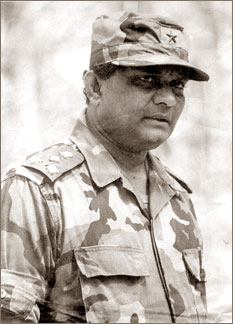
Major General Vanigamuni Indrajith Vijeyakumar Mendis Wimalaratne, RWP, RSP, VSV, USP was a senior Sri Lanka Army officer. One of the most distinguished field commanders in Sri Lanka, Wimalaratne raised the Gajaba Regiment, he commanded the 1st Brigade during the Vadamarachchi Operation, he commanded the Amphibious Task Force Commander during Operation Balavegaya and was the Commander Security Forces – Jaffna at the time of his death in a land mine explosion at Point Arali in the Kayts Island while making preparations to re-capture Jaffna.
Commandant is a title often given to the officer in charge of a military training establishment or academy. This usage is common in English-speaking nations. In some countries it may be a military or police rank. It is also often used to refer to the commander of a military prison or prison camp.

The Sri Lanka Army is the oldest and largest of the Sri Lanka Armed Forces. The army was officialy established as the Ceylon Army in 1949, though the army traces it's roots back in 1881 when Ceylon Light Infantry Volunteers was created; the army was renamed as the 'Sri Lanka Army' when Sri Lanka became a republic in 1972. In 2024, the Army had approximately 150,000 personnel.

The Weera Wickrama Vibhushanaya is the third-highest military decoration awarded by the Military of Sri Lanka for:
...individual acts of gallantry and conspicuous bravery of a military nature of a high order in the face of the enemy performed voluntarily whilst on active service without regard for his own security with the objective of safeguarding thereby the lives of his comrades or facilitating the operational aim of his force or for a meritorious act or a series of acts of a humane nature of a high order displayed in saving life from drowning, fire and rescue operations in mines, floods and similar calamities under circumstances of bodily injury or danger to the life of the rescuer...
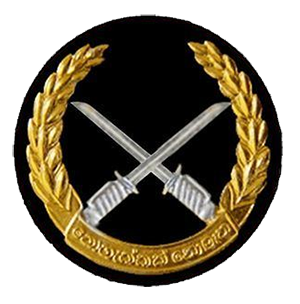
The Commando Regiment is the commando formation of the Sri Lanka Army. The unit specializes in various roles including hostage rescue, counter-terrorism, unconventional warfare, special reconnaissance, counter-insurgency, and personnel recovery. It was formed in 1980 and is based in Ganemulla, a suburb of Colombo.

The Sri Lanka Armoured Corps (SLAC) provides the armour capability of the Sri Lanka Army, with vehicles such as the T-55AM2, and type 80/88 main battle tanks; the BMP infantry fighting vehicle; and the BTR-80, and WZ551 armoured personnel carriers. It comprises five regular armoured regiments, a volunteer regiment, and a regimental band. It has an independent Armoured Brigade and is headquartered at Rock House Army Camp, Colombo.

The Sri Lanka Artillery (SLA) is the artillery arm of the Sri Lanka Army. It is made up of ten regular regiments and two volunteer regiments. The SLA is headquartered at Panagoda Cantonment, Panagoda.
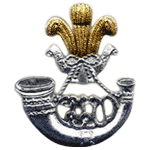
The Sri Lanka Light Infantry (SLLI) is the oldest regiment in the Sri Lanka Army and the oldest infantry regiment in the army. It is made up of sixteen regular battalions and nine volunteer battalions, and is headquartered at the Panagoda Cantonment, Panagoda.

The Sri Lanka Sinha Regiment (SLSR) is an infantry regiment of the Sri Lanka Army; it is the second oldest infantry regiment in the army.

The Gajaba Regiment (GR) is an elite infantry regiment of the Sri Lankan Army. Formed on 14 October 1983 at the Saliyapura Camp in Anuradhapura, it is named after the famous Sinhalese King Gajabahu the First. It consists of 14 regular battalions and 6 volunteer battalions.
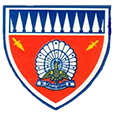
The Gemunu Watch (GW) ("King Dutugemunu's Own") is a infantry regiment of the Sri Lanka Army, formed with troops from the Ceylon Light Infantry and the Ceylon Sinha Regiment in 1962. It has been deployed in many major operations against the LTTE. It is made up of 14 regular units and 9 volunteer units. Headquartered at Kuruwita Army Camp, Ratnapura. It is named after one of the most famous Lankan Kings, King Dutugemunu.
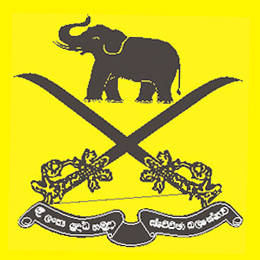
The Sri Lanka Army Volunteer Force (SLAVF) is the active-duty volunteer reserve force of the Sri Lanka Army. The SLAVF is separate from the Regular Force which consists of personal who are professional soldiers and its Regular Reserve, which comprises personal who have a mobilization obligation following their service in the regular army. The SLAVF consists of the volunteer force and the volunteer reserve; administration and recruitment of reserve personal is carried out by the Volunteer Force Headquarters in Shalawa, Kosgama which is headed by the Commandant of the Volunteer Force. It has a current strength of about 55,000 personnel. The SLAVF was known as the Ceylon Volunteer Force from 1949 to 1972 and the Sri Lanka Volunteer Force from 1972 to 1985.
The Ceylon Planters Rifle Corps was a regiment of the Ceylon Defence Force, which existed between 1900 and 1949. It was a volunteer (reserve) regiment based in Kandy, made up of only Europeans that were tea and rubber planters of the hills of Sri Lanka. The regiment deployed personnel to fight in the Second Boer War, the First, and Second World Wars.
The Rajarata Rifles was a former rifle regiment of the Sri Lanka Army. It was one of only three geographically based regiments in the Sri Lanka army. The cap badge of the Raja Rata Rifles show the figure of a Bherunda Pakshiya.
Operation Balavegaya was a combined military operation launched by the Sri Lankan military in Jaffna, the largest amphibious assault in its history. Operation Balavegaya was launched in response to the siege of Elephant Pass by the LTTE. It is believed that Operation Balavegaya was the largest and most successful military operation of the Sri Lankan military until Operation Riviresa in 1995.
General Shavendra Silva, is a Sri Lanka Army four star general who is the current Chief of Defence Staff, the head of the Sri Lanka Armed Forces serving from 1 January 2020. He also served as the Commander of the Sri Lanka Army from 19 August 2019 to 31 May 2022. His other important appointments include, Chief of Staff of the army, Adjutant General and Director of Operations of the Army. During the Sri Lankan civil war he gained fame as the General Officer Commanding of the elite 58 Division. He had also served as the Deputy Permanent Representative to the United Nations Headquarters.

Colonel Candauda Arachchige Dharmapala, OBE, ED was Sri Lankan politician. He was a Parliamentary Secretary to the Minister of Industries, Housing and Social Services and Member of Parliament for Hakmana. He also served as the permanent secretary to the Ministry of Defence, and as Security Adviser to President J. R. Jayewardene.
The Ceylon National Guard (CNG) was a former Volunteer regiment of the Sri Lanka Army that existed from 1963 to 1980. The CNG was formed in 1962 as part of the reforms to the Ceylon Volunteer Force in the Ceylon Army following the 1962 Ceylonese coup d'état attempt in which several volunteer units were implicated. The 2nd (Volunteer) Coastal Artillery Regiment, Ceylon Artillery and the 2nd (Volunteer) Signals, Ceylon Signals Corps were disbanded and personal from these units who were found to be not part of the attempt coup were re-grouped as the 1st Battalion, CNG and 2nd Battalion, CNG. The CNG was mobilized for duty with the Task Force Anti Illicit Immigration and during the 1971 JVP Insurrection. It was finally disbanded in 1980 after the 1st Battalion was transferred to the Sri Lanka Armoured Corps as the 2nd (Volunteer) Regiment, Sri Lanka Armoured Corps in 1979 and the 2nd Battalion was transferred to the Sri Lanka Artillery as the 5th (Volunteer) Regiment, Sri Lanka Artillery in 1980.












